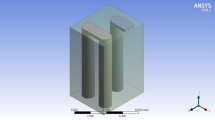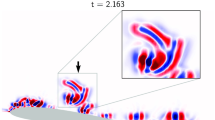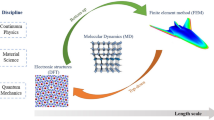Abstract
In this paper, to reduce the computational cost of Proper Orthogonal Decomposition (POD) method in film-cooling problems, a new method based on the combination of POD method with Sparse Polynomial Chaos Expansion (PCE) and Kriging approaches is developed. In the present method, firstly, by combining compressed sensing and POD methods, the optimal basis functions are obtained via low-fidelity calculations. These basis functions are subsequently used in the trend part of the Kriging surrogate model. Then, the trend coefficients and the stochastic Gaussian part are estimated through a limited number of high-fidelity calculations. The performance of the proposed method is investigated on two challenging test cases: 1) film-cooling jet in cross-flow and 2) leading edge film cooling of a gas turbine blade with 7 and 10 uncertain variables, respectively. For the first test case, the new method reduces the computational cost by \(91\%\) and \(53.9\%\) with respect to the full PCE and POD methods. For the second test case, the computational cost reductions are \(81\%\) and \(37.9\%\) in comparison to the full PCE and POD methods, respectively. In general, the proposed method is better in terms of accuracy in comparison to combined POD and compressed sensing, especially in the cases with the lower number of low-fidelity samples.
























Similar content being viewed by others
References
Abraham S, Tsirikoglou P, Miranda J, Lacor C, Contino F, Ghorbaniasl G (2018) Spectral representation of stochastic field data using sparse polynomial chaos expansions. J Comput Phys 367:109–120
Babaee H, Wan X, Acharya S (2014) Effect of uncertainty in blowing ratio on film cooling effectiveness. J Heat Transfer 136(3):031701
Bachoc F (2013) Cross validation and maximum likelihood estimations of hyper-parameters of Gaussian processes with model misspecification. Comput Stat Data Anal 66:55–69
Berveiller M, Sudret B, Lemaire M (2006) Stochastic finite element: a non intrusive approach by regression. Eur J Comput Mech 15(1–3):81–92
Bieri M, Schwab C (2009) Sparse high order FEM for elliptic sPDEs. Comput Methods Appl Mech Eng 198(13–14):1149–1170
Blatman G, Sudret B (2010) An adaptive algorithm to build up sparse polynomial chaos expansions for stochastic finite element analysis. Probab Eng Mech 25(2):183–197
Blatman G, Sudret B (2010) Efficient computation of global sensitivity indices using sparse polynomial chaos expansions. Reliability Engineering & System Safety 95(11):1216–1229
Blatman G, Sudret B (2011) Adaptive sparse polynomial chaos expansion based on least angle regression. J Comput Phys 230(6):2345–2367
Bogard DG, Thole KA (2006) Gas turbine film cooling. J Propul Power 22(2):249–270
Carnevale M, Montomoli F, D’Ammaro A, Salvadori S, Martelli F (2013) Uncertainty quantification: a stochastic method for heat transfer prediction using LES. J Turbomach 135(5):051021
Carnevale M, D’Ammaro A, Montomoli F, Salvadori S (2014) Film cooling and shock interaction: An uncertainty quantification analysis with transonic flows. In: ASME Turbo Expo 2014: Turbine Technical Conference and Exposition, American Society of Mechanical Engineers, pp. V05BT13A001–V05BT13A001
Chen W, Hesthaven JS, Junqiang B, Qiu Y, Yang Z, Tihao Y (2018) Greedy nonintrusive reduced order model for fluid dynamics. AIAA J 56(12):4927–4943
Cheng K, Lu Z, Zhen Y (2019) Multi-level multi-fidelity sparse polynomial chaos expansion based on Gaussian process regression. Comput Methods Appl Mech Eng 349:360–377
D’Ammaro A, Montomoli F (2013) Uncertainty quantification and film cooling. Comput Fluids 71:320–326
Deb K, Pratap A, Agarwal S, Meyarivan T (2002) A fast and elitist multiobjective genetic algorithm: Nsga-ii. IEEE Trans Evol Comput 6(2):182–197
Doostan A, Owhadi H (2011) A non-adapted sparse approximation of pdes with stochastic inputs. J Comput Phys 230(8):3015–3034
Doostan A, Ghanem RG, Red-Horse J (2007) Stochastic model reduction for chaos representations. Comput Methods Appl Mech Eng 196(37–40):3951–3966
Eldar YC, Kutyniok G (2012) Compressed sensing: theory and applications. Cambridge University Press, Cambridge
Fluent A et al 12.0 user’s guide, Ansys Inc 6
Forrester AI, Bressloff NW, Keane AJ (2006) Optimization using surrogate models and partially converged computational fluid dynamics simulations. Proc R Soc A 462(2071):2177–2204
Geisser S (1975) The predictive sample reuse method with applications. J Am Stat Assoc 70(350):320–328
Guo Z, Song L, Park C, Li J, Haftka RT (2018) Analysis of dataset selection for multi-fidelity surrogates for a turbine problem. Struct Multidisc Optim 57(6):2127–2142
Hampton J, Doostan A (2015) Compressive sampling of polynomial chaos expansions: convergence analysis and sampling strategies. J Comput Phys 280:363–386
Haslinger W, Hennecke D (1997) Highly resolved distribution of adiabatic film cooling effectiveness for turbine leading edge film cooling, In: ISABE—International Symposium on Air Breathing Engines, 13 th, Chattanooga, TN, pp. 797–806
Hoda A, Acharya S (2000) Predictions of a film coolant jet in crossflow with different turbulence models. J Turbomach 122(3):558–569
Holland FA (2002) A simple method for estimating the parameters of the beta distribution applied to modeling uncertainty in gas turbine inlet temperature, In: ASME Turbo Expo 2002: Power for Land, Sea, and Air, American Society of Mechanical Engineers, pp. 627–633
Hoyle N, Bressloff NW, Keane AJ (2006) Design optimization of a two-dimensional subsonic engine air intake. AIAA J 44(11):2672–2681
Huang D, Allen TT, Notz WI, Miller RA (2006) Sequential Kriging optimization using multiple-fidelity evaluations. Struct Multidisc Optim 32(5):369–382
Jakeman JD, Eldred MS, Sargsyan K (2015) Enhancing \(\ell _{1}\)-minimization estimates of polynomial chaos expansions using basis selection. J Comput Phys 289:18–34
Jones DR, Schonlau M, Welch WJ (1998) Efficient global optimization of expensive black-box functions. J Glob Optim 13(4):455–492
Joseph VR, Hung Y, Sudjianto A (2008) Blind Kriging: a new method for developing metamodels. J Mech Des 130(3):031102
Kadhim HT, Rona A, Obaida HM, Gostelow JP (2017) Numerical study of the flow past an axial turbine stator casing and perspectives for its management, In: ASME Turbo Expo 2017: Turbomachinery Technical Conference and Exposition, American Society of Mechanical Engineers, pp. V02BT41A002–V02BT41A002
Kersaudy P, Sudret B, Varsier N, Picon O, Wiart J (2015) A new surrogate modeling technique combining Kriging and polynomial chaos expansions-application to uncertainty analysis in computational dosimetry. J Comput Phys 286:103–117
Kumar D, Raisee M, Lacor C (2016) An efficient non-intrusive reduced basis model for high dimensional stochastic problems in CFD. Comput Fluids 138:67–82
Lacaze S, Missoum S (2013) Reliability-based design optimization using Kriging and support vector machines. In: Proceedings of the 11th International Conference on Structural Safety & Reliability, New York
Lakehal D (2002) Near-wall modeling of turbulent convective heat transport in film cooling of turbine blades with the aid of direct numerical simulation data. J Turbomach 124(3):485–498
Lakehal D, Theodoridis G, Rodi W (2001) Three-dimensional flow and heat transfer calculations of film cooling at the leading edge of a symmetrical turbine blade model. Int J Heat Fluid Flow 22(2):113–122
Lucor D, Karniadakis GE (2004) Adaptive generalized polynomial chaos for nonlinear random oscillators. SIAM J Sci Comput 26(2):720–735
Margheri L, Sagaut P (2016) A hybrid anchored-ANOVA-POD/Kriging method for uncertainty quantification in unsteady high-fidelity CFD simulations. J Comput Phys 324:137–173
Mathelin L, Gallivan K (2012) A compressed sensing approach for partial differential equations with random input data. Commun Comput Phys 12(4):919–954
Mohammadi A, Raisee M (2019) Efficient uncertainty quantification of stochastic heat transfer problems by combination of proper orthogonal decomposition and sparse polynomial chaos expansion. Int J Heat Mass Transf 128:581–600
Mohammadi A, Raisee M (2019) Stochastic field representation using bi-fidelity combination of proper orthogonal decomposition and Kriging. Comput Methods Appl Mech Eng 357:112589
Mohammadi A, Shimoyama K, Karimi MS, Raisee M (2021) Efficient uncertainty quantification of CFD problems by combination of proper orthogonal decomposition and compressed sensing. Appl Math Model 94:187–225
Mohammadi-Ahmar A, Raisee M (2020) Multi-fidelity uncertainty quantification of film cooling flow under random operational and geometrical conditions. Int J Heat Mass Transf 152:119548
Mohammadi-Ahmar A, Solati A, Ghasemi J (2018) Numerical analysis on the film cooling of leading edge with laid back holes to determine the optimal angle for the holes. Aust J Mech Eng 18(3):429–441
Mohammadi-Ahmar A, Mohammadi A, Raisee M (2020) Efficient uncertainty quantification of turbine blade leading edge film cooling using bi-fidelity combination of compressed sensing and Kriging. Int J Heat Mass Transf 162:120360
Montgomery DC (2017) Design and analysis of experiments. Wiley, New York
Nair PB, Keane AJ (2002) Stochastic reduced basis methods. AIAA J 40(8):1653–1664
Palar PS, Shimoyama K (2018) On efficient global optimization via universal Kriging surrogate models. Struct Multidisc Optim 57(6):2377–2397
Pati YC, Rezaiifar R, Krishnaprasad PS (1993) Orthogonal matching pursuit: Recursive function approximation with applications to wavelet decomposition, In: Proceedings of 27th Asilomar Conference on Signals, Systems and Computers, IEEE, pp. 40–44
Raisee M, Kumar D, Lacor C (2015) A non-intrusive model reduction approach for polynomial chaos expansion using proper orthogonal decomposition. Int J Numer Meth Eng 103(4):293–312
Sacks J, Welch WJ, Mitchell TJ, Wynn HP (1989) Design and analysis of computer experiments. Stat Sci 4(4):409–423
Sakai E, Bai M, Ahlfeld R, Klemmer K, Montomoli F (2019) Bi-fidelity UQ with combination of co-Kriging and arbitrary polynomial chaos: film cooling with back facing step using RANS and DES. Int J Heat Mass Transf 131:261–272
Salehi S, Raisee M, Cervantes MJ, Nourbakhsh A (2018) An efficient multifidelity \(\ell _{1}\)-minimization method for sparse polynomial chaos. Comput Methods Appl Mech Eng 334:183–207
Santner TJ, Williams BJ, Notz WI, Williams BJ (2003) The design and analysis of computer experiments, vol 1. Springer, New York
Schobi R, Sudret B, Wiart J (2015) Polynomial-chaos-based Kriging. Int J Uncertain Quantif 5(2):171–193
Shi W, Chen P, Li X, Ren J, Jiang H (2019) Uncertainty quantification of the effects of small manufacturing deviations on film cooling: a fan-shaped hole. Aerospace 6(4):46
Shih T-H, Liou WW, Shabbir A, Yang Z, Zhu J (1995) A new k-\(\varepsilon\)eddy viscosity model for high Reynolds number turbulent flows. Comput Fluids 24(3):227–238
Sinha A, Bogard D, Crawford M (1991) Film-cooling effectiveness downstream of a single row of holes with variable density ratio. J Turbomach 113(3):442–449
Sobol’ IM (1967) On the distribution of points in a cube and the approximate evaluation of integrals. Z Vychislitel’noi Matematiki Matematicheskoi Fiziki 7(4):784–802
Stone M (1974) Cross-validatory choice and assessment of statistical predictions. J R Stat Soc Ser B 36(2):111–133
Structural optimization using K]riging approximation, author=Sakata, S and Ashida, F and Zako, M, journal=Computer methods in applied mechanics and engineering, volume=192, number=7-8, pages=923–939, year=2003, publisher=Elsevier
Toal DJ (2015) Some considerations regarding the use of multi-fidelity Kriging in the construction of surrogate models. Struct Multidisc Optim 51(6):1223–1245
Todor RA, Schwab C (2007) Convergence rates for sparse chaos approximations of elliptic problems with stochastic coefficients. IMA J Numer Anal 27(2):232–261
Wan X, Karniadakis GE (2005) An adaptive multi-element generalized polynomial chaos method for stochastic differential equations. J Comput Phys 209(2):617–642
Wang C, Sun X, Zhang J (2019) Uncertainty analysis of trench film cooling on flat plate. Appl Therm Eng 156:562–575
Xiao D, Fang F, Pain C, Hu G (2015) Non-intrusive reduced-order modelling of the navier-stokes equations based on RBF interpolation. Int J Numer Meth Fluids 79(11):580–595
Zhang Y, Yao W, Ye S, Chen X (2019) A regularization method for constructing trend function in kriging model. Struct Multidisc Optim 59(4):1221–1239
Acknowledgements
Part of the work was carried out under the Collaborative Research Project of the Institute of Fluid Science, Tohoku University.
Funding
There is no funding source.
Author information
Authors and Affiliations
Corresponding author
Ethics declarations
Conflict of Interest
The authors declare that they have no conflict of interest.
Replication of results
The authors state that all the data necessary to replicate the results are presented in the manuscript. Relevant parts of the code can be shared by contacting the corresponding author.
Ethical approval
This article does not contain any studies with human participants or animals performed by any of the authors.
Informed consent
Informed consent was obtained from all individual participants included in the study.
Additional information
Responsible Editor: Graeme James Kennedy
Publisher's Note
Springer Nature remains neutral with regard to jurisdictional claims in published maps and institutional affiliations.
Rights and permissions
Springer Nature or its licensor holds exclusive rights to this article under a publishing agreement with the author(s) or other rightsholder(s); author self-archiving of the accepted manuscript version of this article is solely governed by the terms of such publishing agreement and applicable law.
About this article
Cite this article
Mohammadi-Ahmar, A., Mohammadi, A., Raisee, M. et al. Model order reduction for film-cooled applications under probabilistic conditions: sparse reconstruction of POD in combination with Kriging. Struct Multidisc Optim 65, 283 (2022). https://doi.org/10.1007/s00158-022-03384-w
Received:
Revised:
Accepted:
Published:
DOI: https://doi.org/10.1007/s00158-022-03384-w




